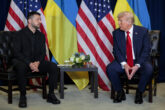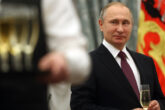August 13, 2015
The United States, NATO, and Dissuading Russian Aggression
This past June, U.S. Secretary of Defense Ashton Carter announced that Washington would pre-position heavy military equipment in eastern and central Europe, a move that would allow the United States to respond more quickly and effectively to Russian aggression toward NATO’s exposed eastern member states. Once deployed, the equipment would serve as a physical sign of commitment of the U.S. willingness to protect NATO allies, and would facilitate further movement of U.S. forces into the region in the event of an attack against NATO frontline states by Moscow. Positioning U.S. military equipment forward is a welcome step, but it does not go far enough in deterring potential Russian aggression and coercion, not least because these deployments represent only a modest force in the face of the power and capabilities Russia could bring to bear in the event of war in the area.
Accordingly, NATO (or, if the alliance as a whole cannot agree to take such action, the United States and other interested members) should pursue a dual-track approach toward the problem that strengthens the alliance’s military posture in the exposed frontline states while simultaneously providing incentives for Moscow to reduce its military threat to these states by offering to limit these deployments. One prong of this policy should be to deploy troops, heavy equipment, and support and headquarters components to exposed NATO members in eastern Europe beyond what the United States has proposed, and do so on a permanent basis, beyond the smaller and avowedly temporary deployments pledged in June. The second prong should be for NATO to propose a new conventional arms control arrangement that would substantially limit (or even roll back) such deployments in exchange for the verifiable withdrawal and exclusion of particularly threatening Russian forces from areas close to NATO territory.
Measures to beef up NATO’s defenses in northeastern Europe in particular are necessary due to Russia’s local military superiority around the shores of the eastern Baltic. With its military advantages, Moscow could invade and occupy portions of the Baltic states and possibly even Poland with relative ease and speed, and thereby present Washington and its NATO partners with a fait accompli. Once situated on NATO territory, Russian forces would be difficult and painful to dislodge, necessitating a bloody military campaign that some NATO states would be reluctant to undertake. The alliance would therefore be well served by having a serious local defense in the area to preclude such a Russian capability. The force would not need to singlehandedly repel a determined Russian attack but, rather, would need to be able only to materially slow, complicate, and retard such an incursion, while also enabling the more effective, secure, and rapid reinforcement of such forces by NATO elements coming from out of the area.
As a consequence, NATO and the United States should build a better defense in Eastern Europe—especially within the Baltics. This should go beyond what the Defense Department announced in June, which represents a step in the right direction but is rotationally manned and thinly spread across NATO’s full eastern perimeter. A more adequately potent posture would emphasize forces designed for territorial defense, especially heavier forces, as these would diminish Moscow’s ability to seize territory quickly and easily. Their presence would also be more likely to dissuade Russian aggression, as any attempt to seize NATO ground in the face of such forces would thus be a much more formidable and dicey proposition that would require a much larger and more brazen effort than currently required. Such an attack would make a NATO response more clearly justifiable and therefore more likely, and thus should encourage caution in Moscow. A stronger deterrent would therefore contribute to—rather than detract from—stability. Larger deployments would also be compatible with a reasonable interpretation of the NATO-Russia Founding Act of 1997, even if the act is now of diminished applicability, given Russia’s aggressiveness in the last year and a half.
From NATO’s perspective, such a conventional arms control regime would mitigate Russia’s threat to the alliance’s vulnerable eastern members. Contrarily, if Moscow rebuffed the offer, its recalcitrance would shift the blame for increased tensions to Russia, thereby generating vital political support in Europe for U.S. and NATO deployments. The United States and NATO pursued a similar dual-track approach in the 1970s and 1980s when the United States deployed intermediate-range nuclear weapons to Europe, then negotiated them away as a bargaining chip that removed the Soviet systems that had prompted their deployment in the first place.
More from CNAS
-
What’s Driving President Trump’s New Confidence in Ukraine’s War Effort
President Trump dramatically declared on social media that he now believes that Ukraine can reclaim all its land from Russia, which he described as a paper tiger. From the Ova...
By Richard Fontaine
-
‘The U.S. Has Got to Get Involved’: Townsend on NATO Boosting Polish Air Defences
Jim Townsend, adjunct senior fellow at the Center for a New American Security, discusses what actions NATO countries need to take amidst Russia’s incursions of NATO airspace.W...
By Jim Townsend
-
Defense / Transatlantic Security
Europe’s Delusions Over What It Means to Deter RussiaToday’s European leaders are in a Singapore trap, crafting a training mission designed to signal resolve rather than achieve an actual military objective....
By Franz-Stefan Gady
-
The Wrong Way to Do Diplomacy With Russia
In fact, the summit helped Putin legitimize Moscow’s grievances, giving Russians who might doubt the wisdom of the invasion reason believe that it was, as Putin promised, just...
By Celeste Wallander




